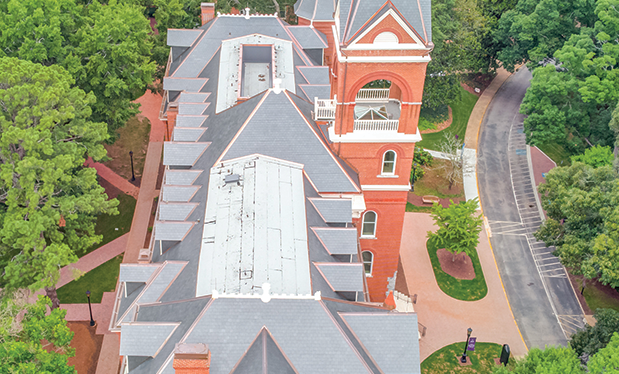ASHRAE 90.1, “Energy Standard for Buildings Except Low-Rise Residential Buildings,” is referenced in the International Code Council®’s International Energy Conservation Code,® International Green Construction Code® and International Mechanical Code.®
A new roofing project may need to meet ASHRAE 90.1 requirements if the building is located within a jurisdiction that enforces IECC or IgCC or has adopted ASHRAE 90.1 as the local energy code. The local building department where a project is located can provide the current adopted energy code and any local amendments.
If a local jurisdiction has adopted IECC in its entirety, Chapter 4-Commercial Energy Efficiency of the Commercial Provisions allows compliance with the applicable sections of IECC or ASHRAE 90.1. If not explicitly stated in a local amendment to IECC, the version of ASHRAE 90.1 to be followed is contained in Chapter 6-Referenced Standards of the Commercial Provisions. IgCC, Chapter 11-Normative References contains the version of ASHRAE 90.1 to follow. The International Building Code® and the International Existing Building Code® require roof system replacements to comply with IECC.
Because ASHRAE 90.1 affects roof systems, you should be aware of recent ASHRAE 90.1 activity and updates.
Background
ASHRAE 90.1 provides minimum energy-efficient requirements for the design and construction of new and existing commercial buildings, as well as additions to existing commercial buildings. The standard also provides requirements for the plan and operation of new systems and equipment in new commercial buildings, existing buildings and additions to existing buildings.
Specifically, the standard requires an operating manual and maintenance manual be provided (commonly by the design professional or installing contractor) to the building owner or designated representative within 90 days of acceptance of the building envelope, which includes the roof system. The manual must clearly identify any required routine maintenance. In addition, a signed and dated insulation document is required that provides the insulation type, manufacturer, manufacturer’s rated R-value and installed thickness.
But whether the maintenance manual and insulation document outlined in ASHRAE 90.1 are required for a roof system replacement when no other work is performed on a building envelope is unclear, and the current standard does not define roof system replacement.
ASHRAE 90.1 also provides criteria for determining compliance with its requirements. For example, a new roof system used as a component of a building envelope’s continuous air barrier must have a maximum air leakage rate of 0.004 cfm/ft2 at a minimum test pressure of 1.57 psf when tested in accordance with ASTM E2178, “Standard Test Method for Determining Air Leakage Rate and Calculation of Air Permeance of Building Materials.”
The standard also lists deemed-to-comply materials, such as foil-faced polyisocyanurate insulation, built-up roof membranes, polymer-modified bitumen roof membranes and single-ply membranes.
ASHRAE 90.1 explicitly states its requirements are not to be applied to low-rise residential buildings, including single-family homes, multifamily buildings of three stories or fewer above grade, manufactured houses (mobile homes) and manufactured houses (modular). Buildings that do not use electricity or fossil fuels also are not covered by the standard.
The process
The standard’s current edition was published in October 2019 and is due for an update this year. The 2019 version is referenced in IECC 2021, and ASHRAE 90.1-2016 is referenced in IECC 2018.
As previously stated, local jurisdictions also may elect to adopt the most current version of the standard before it is adopted in the IECC in which it is referenced. Local jurisdictions also may adopt other versions of ASHRAE 90.1 in lieu of the version referenced in the adopted IECC.
The ASHRAE 90.1 update process is similar to the I-Codes process. Both go through a public review and comment period and have voting members approve different documents. The I-Codes, with exception of the IECC, are reviewed by a committee of about 15 members with final approval voted on by ICC’s governmental members (code officials) from throughout the U.S.
Forty to 50 committee members approve ASHRAE 90.1 for publication. The I-Codes are updated and modified every three years, which is the only time changes may be submitted. ASHRAE 90.1 also is published every three years and ahead of the associated I-Codes.
ASHRAE 90.1 is a continual-maintenance document, which means it can be revised or updated at any time. A proposed change to the standard may be submitted between publication dates. If approved, the change is published as an addendum that immediately can be adopted by a jurisdiction as a mandatory requirement. Then, at the next publication date, all approved addenda since the previous publication date are automatically incorporated into the new published standard.
Since the publication of ASHRAE 90.1-2019, 40 addenda have been published that will automatically be incorporated into ASHRAE 90.1-2022. Of the 40 addenda, two indirectly involve roof systems.
Addendum s removed the current definition of “reflectance” without substitution because of its inaccurate definition. The term is used when establishing a roof’s solar reflectance minimum criteria. Addendum by establishes requirements for on-site renewable energy for buildings. Depending on the project site, this could require installation of such equipment on a roof. However, there are exemptions if a roof area is covered with other equipment or more than 50% of the roof area is permanently shaded for more than 2,500 hours annually between 8 a.m. and 4 p.m. The other 38 addenda involve mostly mechanical and lighting revisions.
ASHRAE’s Standing Standards Project Committee is responsible for maintaining ASHRAE 90.1 and comprises five subcommittees. The Envelope Subcommittee, of which NRCA is a voting member, is charged with addressing issues related to roofing, such as R-value and insulation, air barriers and thermal bridging.
Typically, the Standing Standards Project Committee and Envelope Subcommittee meet face-to-face four times annually. In addition, the subcommittee also conducts business regularly via conference calls twice per month.
2021 activity
For the first time since January 2020, the Standing Standards Project Committee and Envelope Subcommittee met in person Oct. 13-15, 2020, at ASHRAE’s new headquarters in Peachtree Corners, Ga., for its fall meeting. Between June 2020 and June 2021, the committee and subcommittee meetings were held virtually.
During 2021, the Standing Standards Project Committee and Envelope Subcommittee reviewed and published Addendum s to ASHRAE 90.1. The Envelope Subcommittee continued its review and development of proposed addenda that address thermal bridging; air leakage; commissioning; new buildings, additions and alterations; and Appendix A. The subcommittee also developed a roof system replacement addendum.
The first public review for the thermal bridging addendum occurred in August 2018 and received 246 comments made by 41 commentors. A third public review occurred in late 2021, which received 10 comments from four commentors. The Envelope Subcommittee reviewed each comment and responded to the commentors. Some comments were found persuasive and were incorporated into the draft addendum in preparation for a fourth public review in 2022.
The review period can be 30, 45 or 60 days based on the Standing Standards Project Committee chairman’s request. A 30-day review period only is permitted when the proposed addendum is fewer than one page.
Other examples affecting the roofing industry as a result of the thermal bridging addendum are roof edges, parapets and equipment support stands. Currently, the thermal bridging addendum exempts fasteners for insulation and/or membrane attachment.
The Envelope Subcommittee also continued its review and development of a proposed building air leakage addendum. A few items being discussed for this addendum include termination or tie-ins to roof membrane perimeters, penetrations through the membrane, building pressurization testing, roof detail review and roof system installation observation requirements. The proposed addendum as currently drafted exempts roof recovers and roof system replacements from meeting the air leakage requirements if the energy use of the building is not increased as a result of the work.
During 2021, the subcommittee decided determining the R-value of tapered insulation roof systems and addressing physical limitations when reroofing caused by existing rooftop conditions when increasing insulation thickness to meet minimum R-value requirements should be separated into two addenda. The latter went through its first public review at the end of 2021 and received five comments from two commentors.
Three draft addenda from the Standing Standards Project Committee and Envelope Subcommittee have the potential to be published this year and accepted into ASHRAE 90.1-2022: thermal bridging, air leakage and roof system replacement insulation conflicts.
Reducing energy consumption
ASHRAE 90.1 seeks to reduce the energy consumed by buildings, and updating the standard to reflect current technologies is an ongoing process. NRCA will continue to keep you informed of any new developments.
GLEN CLAPPER, AIA, LEED AP, is an NRCA director of technical services.


